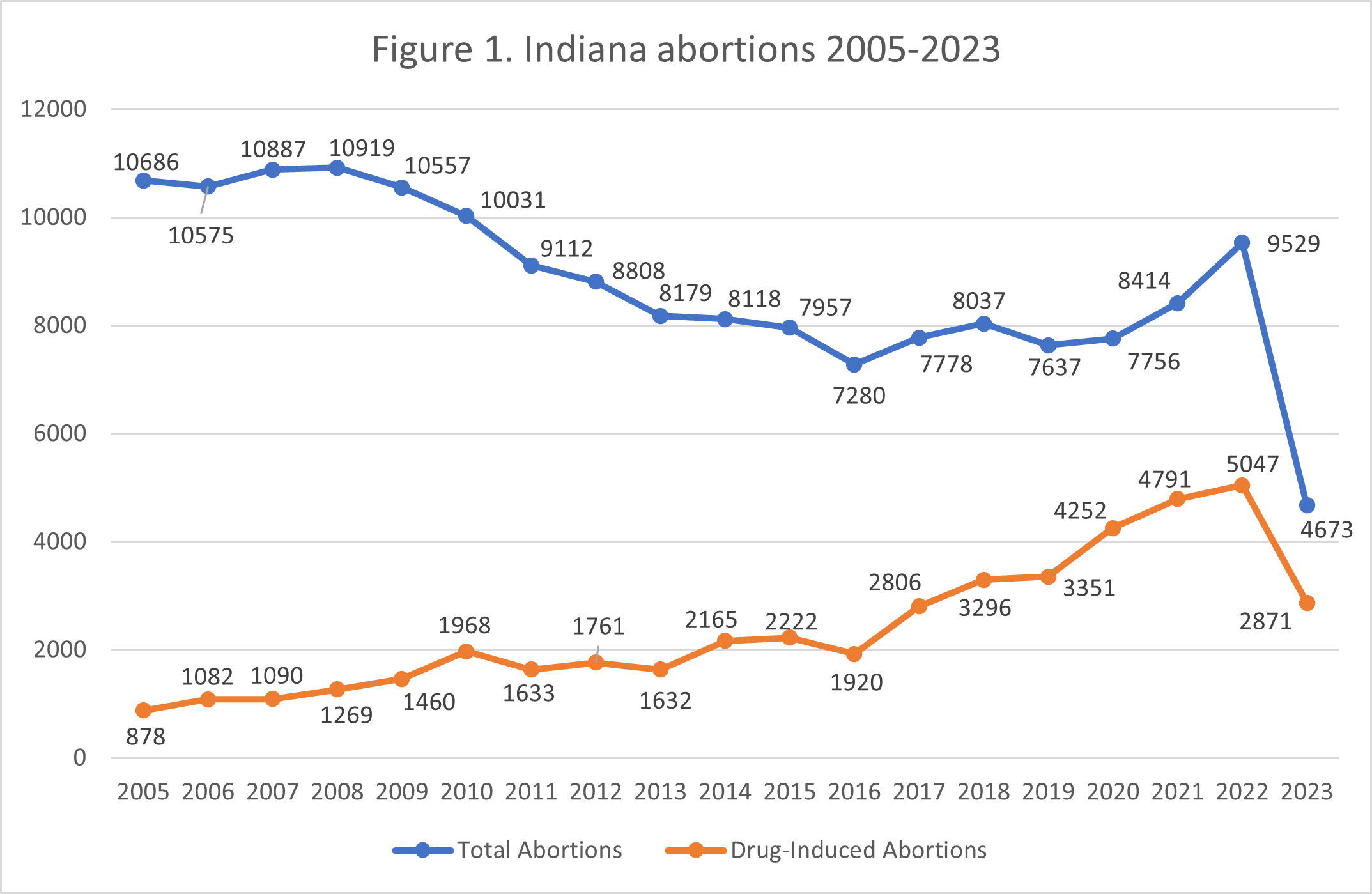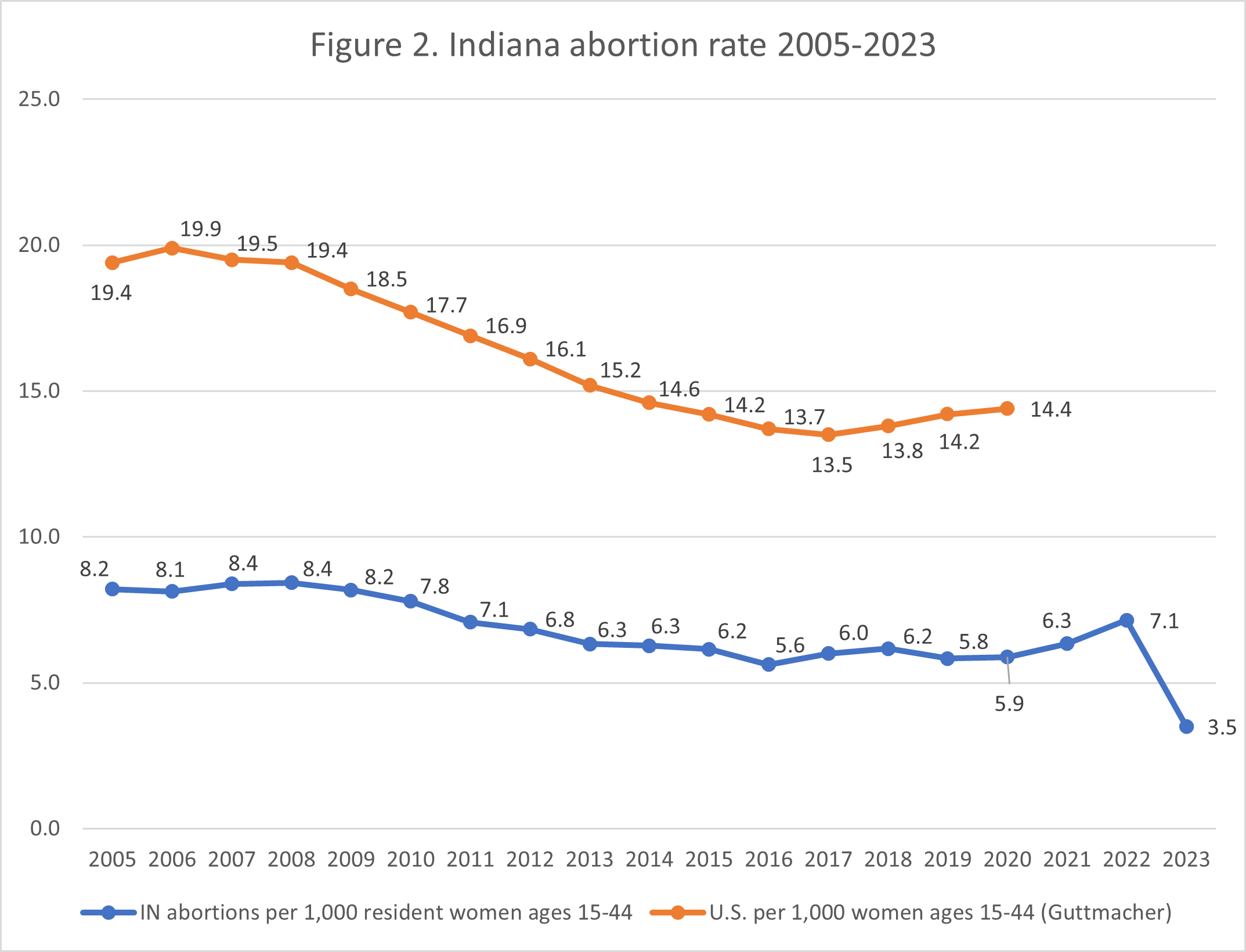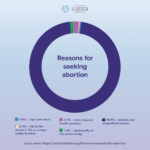Abortion Reporting: Indiana (2023)
Indiana’s 2023 quarterly abortion reports were published by the Indiana Department of Health (IDOH) throughout the year and into early 2024. Indiana changed to quarterly reporting for 2023 and, as a result, this data represents the summation of the data in the quarterly reports. These reports showed that abortions in Indiana decreased significantly from 2022, likely due to the state’s life at conception law going back into effect in late August 2023.
Statistics and Changes in Indiana Abortions, 2022-2023

Abortion Totals and Trends
In 2023, there were 4,673 abortions reported in Indiana, down 51% from the previous year. Drug-induced abortions decreased by 43% but still composed 61% of the total (Fig. 1). The Charlotte Lozier Institute (CLI) estimates that Indiana’s 2023 abortion rate was 3.5 abortions per 1,000 women ages 15 to 44, a decrease of 51% from 2022 (Fig 2).1 As of May 2024, six states have released 2023 abortion statistics, with four states showing decreases in abortions from 2022 to 2023.
State Report Summary
In 2023, 82% of the abortions reported in Indiana were performed on state residents, around the same percent as the previous year. Eighteen percent were obtained by nonresident women, including 16% from Kentucky. Nonresident abortions were also performed on residents of Ohio, Tennessee, Michigan, and Illinois. Less than one percent of Indiana abortions were performed on women from other nonresident states. One reason for the high percentage of Kentucky women who received abortions in Indiana may be that Kentucky’s life at conception law has been in effect since August 2022, whereas Indiana’s similar law was blocked a few days after it passed in September 2022 before finally going back into effect in August 2023.
The way that Indiana categorized the ages of women getting abortions changed for quarters three and four due to the state’s pro-life law, containing changes to the state’s reporting requirements and going into effect in August. For quarters one and two, 9% of abortions were performed on girls ages 19 or younger. Thirty percent of Indiana abortions during those quarters were obtained by women ages 20 to 24, 28% by women ages 25 to 29, and 29% by women in their thirties. Also in quarters one and two, 3% of women ages 40 or older obtained abortions. In quarters three and four, six abortions were performed on girls under the age of 16 while 40% were performed on women and girls ages 16 to 24 and 46% on women ages 25 to 34. Thirteen percent were performed on women 35 to 44 while two abortions were obtained by women 45 and older.
In 2023, 44% of Indiana abortions were performed on white women, 38% on black women, and three percent on Asian women. American Indiana/Alaska Native women as well as Pacific Islander women constituted 0.1% of the total each. One percent of abortions were performed on women of multiple races while 9% were performed on women of other races. Five percent were performed on women of an unknown race. CLI estimates that the black abortion rate (11.3 abortions per 1,000 women ages 15 to 44) was six times the white abortion rate (1.9). Eighty-four percent of Indiana abortions were obtained by non-Hispanic women while 13% were obtained by Hispanic women. Three percent of the abortions performed in the state were on women of unknown ethnicity.
One percent of abortions performed in Indiana were on women with an eighth-grade education or less and 7% on women who had attended but not completed high school. Thirty-seven percent of Indiana abortions were obtained by women with a high school diploma or its equivalent as their highest level of education, and 23% were obtained by women who had completed some college but did not have a degree. Twenty percent of abortions were performed on women with a college degree. Level of education was unknown for 11% of the abortions.
Eighty-eight percent of the abortions reported in Indiana were obtained by unmarried women and 12% by married women. Thirty-seven percent of Indiana abortions were performed on women with no living children. Just over a quarter (26%) were on women with one child, and 37% on women with two or more children. Sixty-seven percent of the abortions were on women with no previous abortions, compared to 21% on women with one prior abortion and 12% on women with more than one. Nineteen percent of the abortions were performed on women who had previously had a miscarriage.
The majority of the abortions reported in Indiana, 61%, were induced with abortion drugs. Thirty-nine percent were surgical, a category that includes suction curettage, menstrual aspiration, dilation and evacuation, and other procedures, although the reports did not include the percentage of abortions performed by each specific procedure type. Sixty-one percent of Indiana abortions occurred at eight weeks of gestation or earlier. Thirty-six percent were performed between nine and 13 weeks, while 2% occurred between 14 and 20 weeks of gestation. Forty abortions were performed at 21 weeks or later.
Forty-four percent of Indiana abortions were performed in Planned Parenthood’s four abortion centers, while independent abortion centers performed 52%, with 32% of abortions being performed by the Women’s Medical Center of Indianapolis and 20% by the Clinic for Women. Hospitals performed 4% of Indiana abortions in 2023.
The month of March had the most abortions performed (729) while the months of August through December averaged 22 abortions a month. To see the breakdown of abortions by month in 2023, please see the table below. After Indiana’s law protecting life at conception went into effect, just 60 abortions were performed from September 2023 through December 2023, while 2,461were performed during those same months in 2022 and 2,663 in 2021.
| Total # of Abortions | |
| January | 546 |
| February | 652 |
| March | 729 |
| April | 617 |
| May | 633 |
| June | 687 |
| July | 697 |
| August | 52 |
| September | 14 |
| October | 12 |
| November | 16 |
| December | 18 |
| Total | 4673 |
Additional Information Reported in 2023 Quarterly Reports
As mentioned above, several changes occurred to Indiana abortion reporting after quarter two in 2023. For that reason, additional reporting requirements went into effect for quarter three and four data. One baby was reported to have been born alive during an abortion (quarter four). The state’s “reason for abortion” data covers abortions from August 21, 2023, through the end of the year. During this time, 63 abortions were performed, with 49% performed because the unborn child had a fetal anomaly and 44% performed because the mother’s life or physical health was at risk. Four abortions were performed due to rape or incest.
A breakdown of the type of abortion drug regimen used was provided for quarter three and four abortions. During these two quarters, 574 drug-induced abortions were performed. Ninety-seven percent of those drug-induced abortions utilized mifepristone and misoprostol, while 3% were performed via intracardiac injections to the unborn baby. All women who obtained mifepristone/misoprostol abortions in quarter three were provided with the manufacturer instructions and signed a patient agreement. In quarter four, 15 women obtained mifepristone/misoprostol abortions. Twelve women received manufacturer instructions and signed a patient agreement, one woman received the instructions but didn’t sign the patient agreement, and two women did not receive the instructions but signed the patient agreement regardless.
Another piece of information Indiana started providing for quarters three and four was the number of abortion reports submitted within the required 30 days to the IDOH for abortions performed on girls and women 16 and older, and within three days to the IDOH and Indiana Department of Child Services (DCS) for abortions performed on minors under 16. Ninety-one percent of reports for abortions performed on women ages 16 and older in quarters three and four were reported to the IDOH on time, while 8% were not. All six abortion reports for girls under 16 were reported to DCS on time, although one report of an abortion on a girl under 16 was not reported on time to IDOH.
A breakdown of abortions by gestational week and type of procedure was provided for quarters three and four. There was a total of 809 abortions in these two quarters, with 54% performed via abortion drugs at eight weeks of gestation or earlier. Seventeen percent were performed via abortion drugs after eight weeks, and 12% were performed via surgical abortion at eight weeks or earlier. Seventeen percent were performed via surgical abortion after eight weeks of gestation. In quarter three, 13 of 14 intracardiac injection abortions utilized an additional procedure (11 dilation and evacuation abortions, one mifepristone/misoprostol abortion, and one hysterectomy). In quarter four, four of six intracardiac injections used an additional procedure (four dilation and evacuation abortions).
Abortion Complications
In October 2021, a new abortion complication reporting law (SB 340), originally passed in 2018, was allowed to go into effect following a decision by the Seventh Circuit Court of Appeals. This law requires the Indiana Department of Health to publish a separate report summarizing abortion complication data. Complications reported before the law went into effect on October 28, 2021, were included in the state’s 2021 annual abortion report, and complications reported after were collated and published in a separate report.
The 2023 complication reports were also released quarterly.2 In 2023, 117 complication reports were filed with information on 136 complications (patients can have more than one complication listed on a report). In 2023, 91 of the 117 complication reports were associated with drug-induced abortions, including five known to have resulted from mail-order abortions. Twenty complication reports involved surgical abortions, one involved an abortion using both abortion drugs and a surgical procedure, another resulted from a labor induction abortion, and four involved an unknown method.
The most frequently reported complication was incomplete abortion (retained tissue), with 70 cases reported, double the number reported in 2022, despite the fact that the total number of abortions decreased by half from 2022 to 2023. There were 26 failed abortions, 19 cases of vaginal bleeding, nine cases of infection, and eight other uncategorized complications. There were two cases of psychological complications and one case each of an allergic reaction to the abortion drug regimen and an unknown complication.
Women were admitted to the hospital in 10 cases, 65 complications resulted in surgical intervention, four complications required blood transfusions, and 11 complications were treated with medication. In nine cases, other treatment was used, and an unknown treatment was utilized 31 times. Overall, 84% of the complication reports noted that the initial abortion provider was not the one who treated the woman’s complication(s).
The 2023 complication report included information on the facilities where the patient presented with complications and the number of reports by the facility performing the abortion. Nineteen of the facilities that treated women for abortion-related complications reported zero abortions in Indiana in 2023. Furthermore, the 2023 complication reports showed that 326 abortions were provided at clinics or hospitals that did not treat any complications. There were nine complication reports stemming from abortions that were performed outside of Indiana (seven from Illinois facilities and two from Michigan facilities), while 58 reports were from abortions performed in Indiana. Fifty complication reports resulted from abortions that were performed at an unknown location.
State Ranking
In 2016, CLI evaluated abortion reporting across the 50 states, New York City, and the District of Columbia, and Indiana’s reporting was ranked 5th best. Since then, Indiana has vastly improved its reporting requirements by improving the timeliness with which the state publishes its reports and strengthening its complication reporting law. Due to pro-life legislation that passed in September 2022 and went into effect in August 2023, data on babies who survive abortions as well as data on the reasons women obtain abortions in the state were included in Indiana’s quarterly reports. Indiana could further improve its abortion statistics by maintaining the same categorizations for different demographic groups and data points throughout the quarterly reports.


- National rates were calculated by the Guttmacher Institute. Indiana rates were calculated by CLI using the following formula: (total number of abortions performed in Indiana ÷ number of resident women ages 15-44 [based on most recent population estimates]) x 1,000. Rates may differ slightly from previous CLI articles due to revised population estimates. Population estimates were obtained from the CDC WONDER database. Estimates for 2005-2009 are intercensal estimates of the July 1 resident population. Estimates for 2010-2019 are Vintage 2020 postcensal estimates of the July 1 resident population. Estimates for 2020-2022 are Vintage 2022 postcensal estimates of the July 1 resident population. Estimates were produced by the U.S. Census Bureau and the National Center for Health Statistics. To calculate the 2023 rates, the Vintage 2022 postcensal estimates were used because 2023 population estimates have not yet been released by the CDC.
- Statistics on abortion complications reported here represent a minimal number of deaths and complications, as this data is collected in a non-systematic and non-verifiable way. As such, this data cannot be used to calculate either an accurate abortion mortality rate or an accurate abortion complication rate for the state.
Click here to view reporting from:2024202220212020201920182017




























